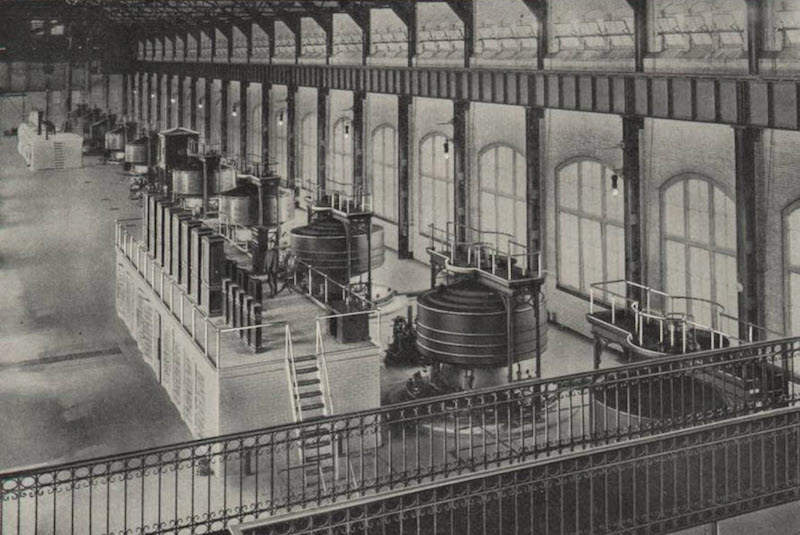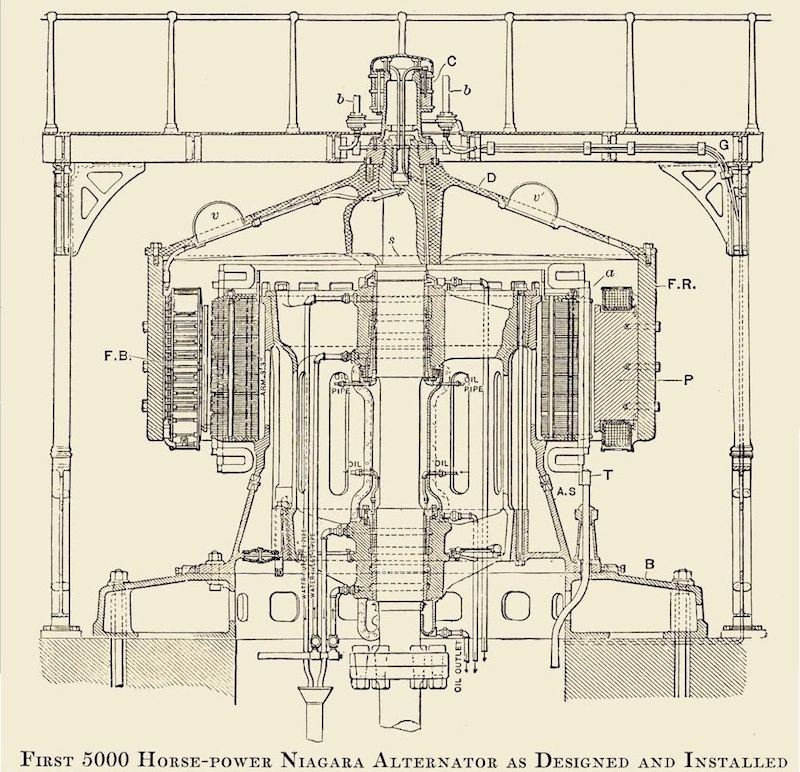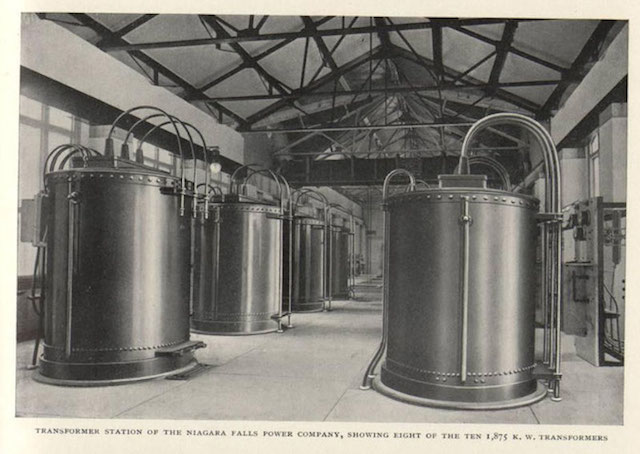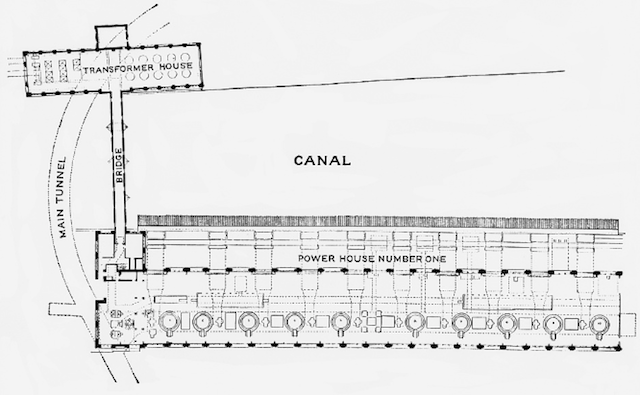Tesla
AC technology for the Adams Power Plant near Niagara Falls
| It is often erroneously believed that the first AC power plant was built exactly on the Niagara Falls. However, originally there were Power Houses 1 and 2 built about two km upstream with respect to the Niagara Falls. Since 1927, the official name of power houses which first implemented "Tesla Polyphase System" was the Adams Power Plant. In this article we indicate the precise location of Power Houses 1 (completed in 1895 with only 3 dynamos) and 2 (completed in 1903). On the Niagara Falls themselves, due to harsh conditions and being a nature protected area, there was no power plant nor any other industrial facility. |
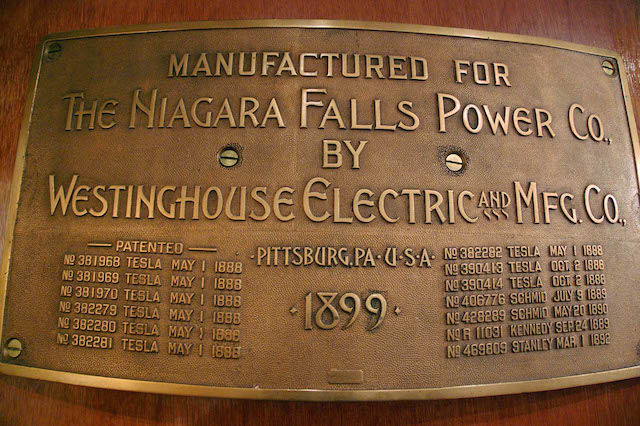
As many as nine crucial 1888 patents due to Nikola Tesla were used.
This technology is based on Tesla's polyphase system:
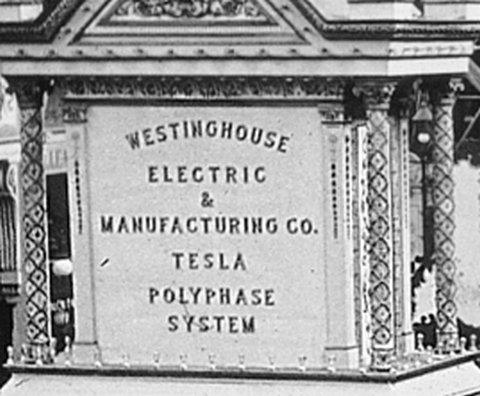
Tesla's polyphase system was exploited in 1893 for the needs of the World Columbian Exhibition in Chicago,
marking the then 400th anniversary of the discovery of America (1492-1892).
The exhbition was solemnly opened by Grover Cleveland, president of the USA.
- Westinghouse Electric & Manufacturing Company,
Pittsburgh, PA, for power
generators,
- General Electric, NY, for transformers
- and I. P. Morris Company of Philadelphia for 29-ton turbines, based on the design of the Swiss company Faesch and Piccard.
which were the biggest power generators at the time and were 5 m in diameter.
Nowadays, the biggest power generators reach 1 000 000 hp and have circa 20 m in diameter.
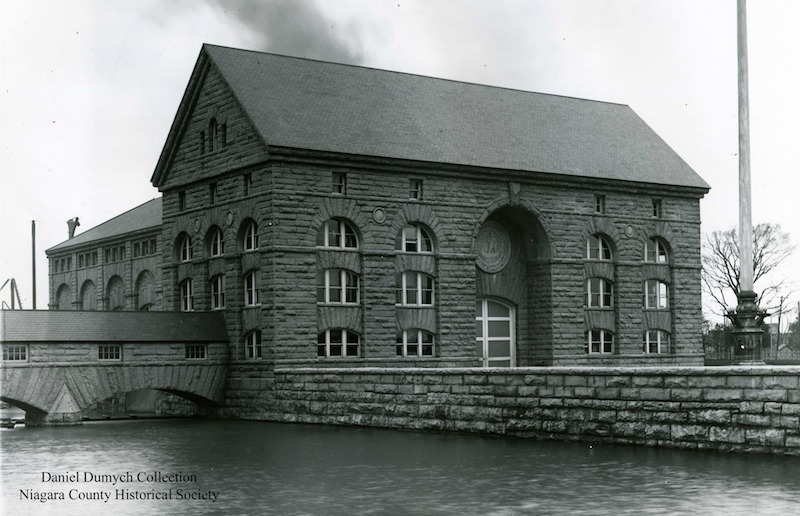
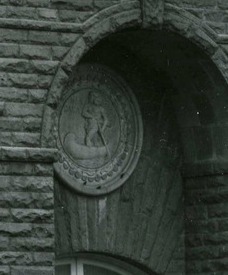
In relation to above-mentioned, the emblem on the entrance portal of the power house, existing since 1895, represents a Mohawk Indian (Native American) standup paddling a canoe.
The Adams Power House No 1 building was originally 42.7 metres long and initial power was three times 5000 hp, i.e. 15,000 hp, although later expanded to 137.2 metres long and gradually (1896-1900) reached ten times 5000 hp, i.e. 50,000 hp when all generators (1900.) were installed.
The bridge on the left side connects Power House No 1 and Transformer House across Adams Slip "carrying" 2200 V and 410 A of two-phase current for primary side of each 1250 hp square-form unit or 820 A of two-phase current for primary side of each 2500 hp round-form unit in step up Transformer House.

Buffalo was the first USA city exploiting Tesla's AC energy system
Hamilton was the first such city in Canada.
The Niagara river is formed from the Erie lake near Buffalo.
The border between Canada (on the left) and the USA (on the right) follows the Niagara river.
Niagara Falls is meant in this article as the set of three large waterfalls on the Niagara River.
Niagara Falls if mentioned as city is the Niagara Falls, New York, United States.
Not to confuse with Niagara Falls (CA) which is the town Niagara Falls, Ontario, Canada.
| Photos appearing on this web page are from various sources on the Internet. We also made use of Google Maps. This is a non-profit web page. |
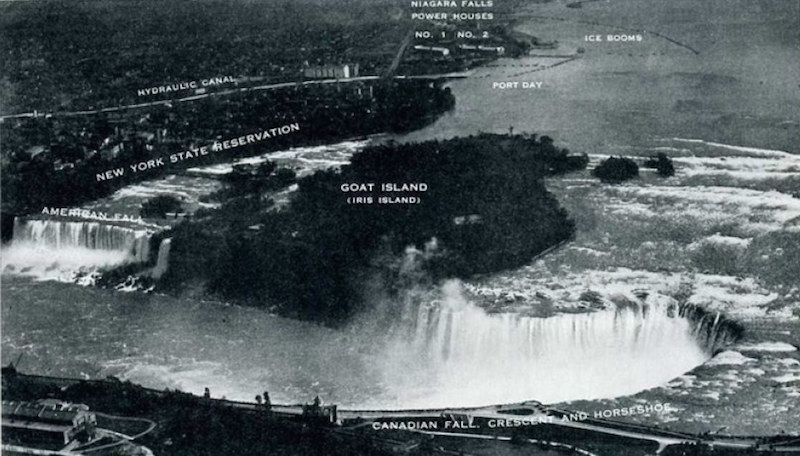
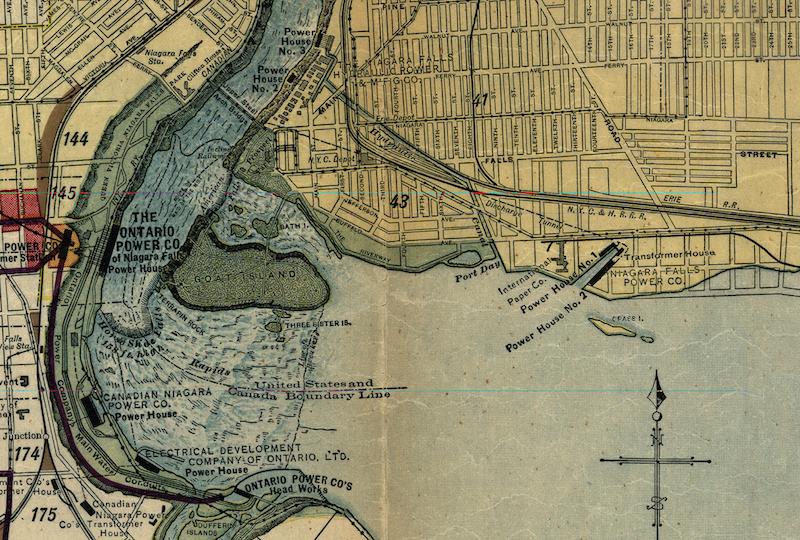
They were both active until
1926, when the new Schoellkopf Power
House No 3c was completed (1924-1956, 210,000 hp), using Tesla's
AC
technology. See on the above photo - downstream with respect to Niagara
Falls, i.e. on the top left.
The same holds for the nearby Schoellkopf Power
House No 2, 1898-1921, (34,000 hp, DC for NF PRC Plant No 2).
There was also the Schoellkopf
Power House No 1, 1882-1904, which had 1800 hp (DC!) for Cliff Paper Company.
Schoellkopf
Power House No 3a, 1914-1961, had 130,000 hp (AC), while
Schoellkopf
Power House No 3b, 1918-1961, had 112,500 hp (AC).
It is notable the
Z-form of the "Niagara River - Adams Slip - Discharge Tunnel"
formation, which enables efficient protection of the Adams Power Plant
water intake from devastating river deposits like wood, ice, snow...
Also, note the lack of such Z-form protection in the case of earlier
Port Day Hydroelectric Canal.
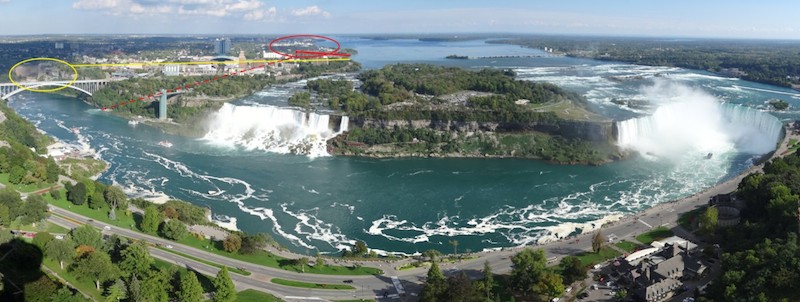

| Yellow ellipse indicates the location of initial/old Niagara Falls (US) industrial zone: the High Bank (Milling District) along the gorge rim somewhat down river from the Falls. Yellow line indicates historical "Hydraulic Canal" providing hydro-energy for mentioned industrial area. Water stream was from Port Day to Hydraulic Basin above High Bank. Owner of the canal and basin was Schoellkopf with his Niagara Falls Hydraulic Power and Manufacturing Company. This industrial area was initialy powered by Schoellkopf's (No 1) Cliff Paper Company DC Power House, which in 1895. had 1800 hp. Red ellipse indicates the location of second (which was new in 1895.) industrial zone: the Buffalo Avenue industrial area to the east of the Reservation State Park. This new industrial area was powered by Tesla's AC high-power 50000 hp Power Plant No 1 and 55000 hp Power Plant No 2, officially Adams Power Plants. Red line indicates Adams Slip providing hydro-energy for the second industrial area. Dashed red line illustrates the path of the Discharge (Tailrace) Tunnel. The land for entire industrial area was owned by the Cataract Construction Corporation. The power plant which started this industrial area was owned by Edward Dean Adams with his The Niagara Falls Power Company. |
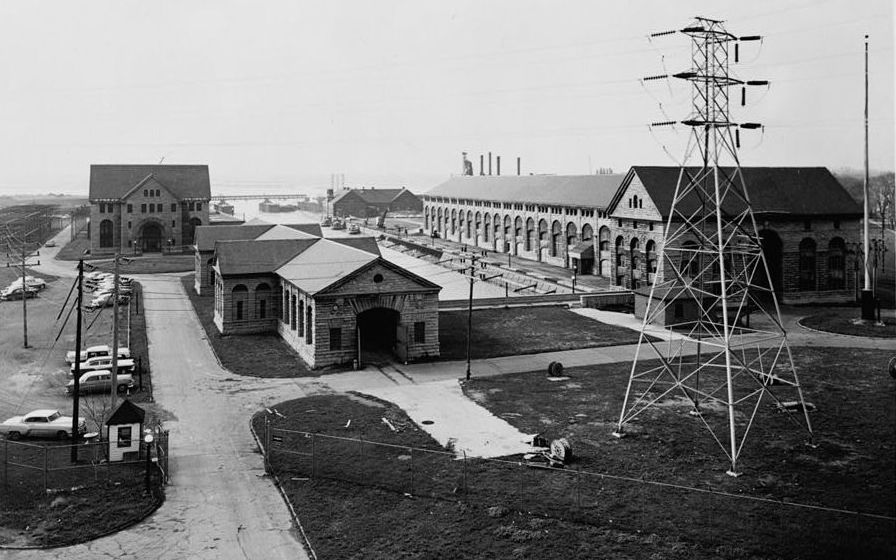
Between power houses is a chanel providing incoming water supply.
A small square building, just in front of Power House No 1, serves as revision access to discharge water tunnel.
| Discharge water (tailrace) tunnel is at the depth of 49 m with respect to chanel providing incoming water supply (Adams Slip). This tunnel is 2042 m long, 6 m high and 5 m wide. It ends 110 m upstream of the present Rainbow International Bridge, i.e. close downstream of the collapsed Upper Steel Arch Bridge. The depth of 49 m defines the potential hydro-energy of the plant. The turbines are around 49 m below the power generators (dynamos). See the picture below, on the left. |
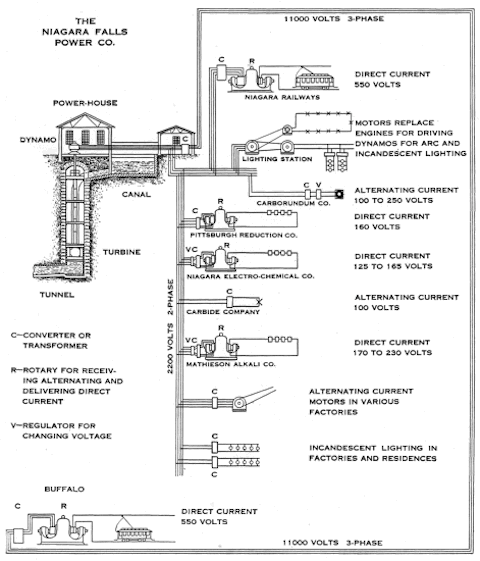
the most important users of Tesla's power plants near Niagara Falls.
Pittsburgh Reduction Co. was an important aluminum producer. Because of Tesla's AC technology,
the price of aluminum was significantly reduced.
In 1893, before a single watt of power had been generated there, industrialist Chester Martin Hall - founder of the Pittsburgh Reduction Company, later renamed Alcoa - announced that his company would be moving to the falls.
After initial testing of the newly built Adams Power Plant, the first alternating current generated by Niagara Falls flashed off to No 1 Niagara Falls Buffalo Avenue plant (Upper Plant) of the Pittsburgh Reduction Company (later Aluminum Company of America, or ALCOA) which ceased production in 1919, when mentioned NF PRC (i.e., Niagara Falls Pittsburgh Reduction Company) No 1 was acquired by The Carborundum Company.
Before Hall, Paul Héroult (Hall–Héroult process of production) and Tesla, aluminum was so expensive that sometimes exceptional guests used aluminum cutlery, other used gold, silver, etc.
Aluminum has had an essential part in aerospace history from its very inception: An aluminum copper alloy (with a copper composition of 8 percent by weight) was used in the engine that powered the historic first flight of the Wright brothers in 1903. Was it the Wright brothers' synergy with Hall and Tesla?
Another great invention of Nikola Tesla - induction (asynchronous) motor, was synergic addition to his fully studied, unprecedented, high-power, long-distance, multi-tenant, ready for commercial use and fully scalable use AC power system. "Tesla Polyphase System" became proven in reality brand of Westinghouse Electric.
The first Niagara Falls Pittsburgh Reduction Company plant was supplied with the DC voltage of 160 V after rotary converters. If the voltage drop for one (molten metallic) aluminum production electrolytic cell or pot was 3,85 V, it can be estimated that there was a “potline” of 40 pots in series . If a total of 5,000 hp (3,700 kW eventually dissipated as heat) in rotary converters were installed, current could reach as much as 16 kA. Pot currents from 10 to 20 kA were also common later in 1914 . Nowadays, aluminum smelting currents can reach up to 600 kA.
Aluminum became an important factor in lowering the price of Tesla's induction motor or asynchronous motor, development of which was also contributed by other great inventors and engineers. The variant of asynchronous motor just mentioned is called a squirrel-cage induction motor, where the cage can be of cast aluminum.
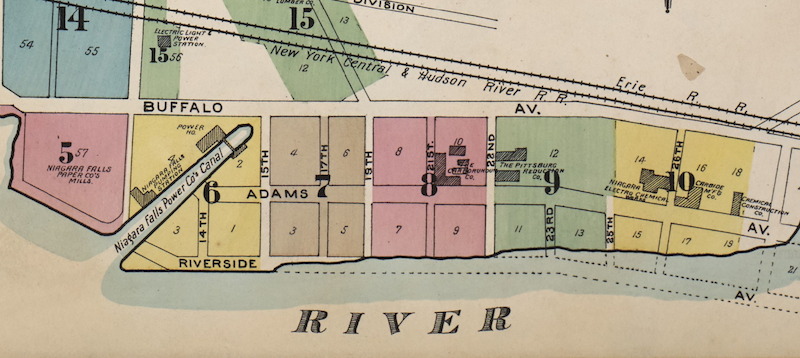
With the financial support, the Cataract Construction Corporation (consisting of J.P. Morgan, John Astor, William Vanderbilt and Edward Dean Adams) built a shortened version of the power tunnel before deciding on a method of power distribution. They acquired a 1,500 acre tract of land above (upstream of) the Reservation State Park for industrial tenants.
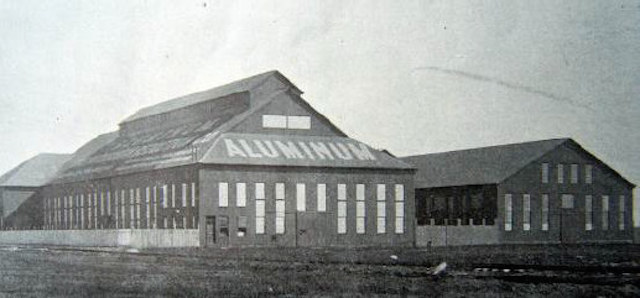
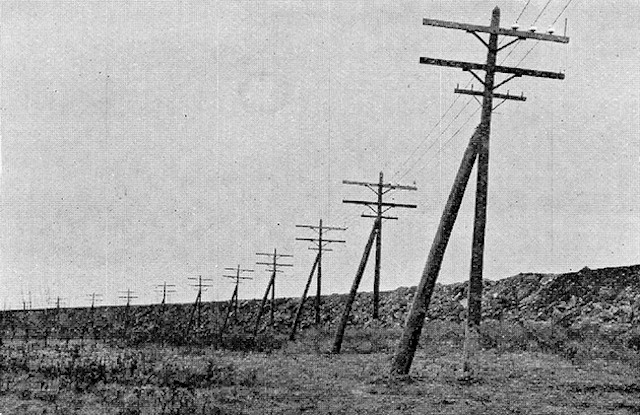
At the Buffalo end there were three 250 kW (i.e. in total 1000 hp ) 11,000 V step down to 375 V transformers. Overall efficiency was almost 80%.
Additional power generators in Adams Power Plant No 1 were added not only because of requests for additional power, but also to provide separation in case of short-circuit or overload protection of distribution circuits. Reliable high power and high voltage switching protection devices did not exist yet. So overload, error or vandalism in one distribution circuit turned down the entire Niagara Falls and Buffalo "power grid". Also, when the main switch of one distribution circuit should be turned off they needed an additional man with a bin of sand to extinguish the arc.
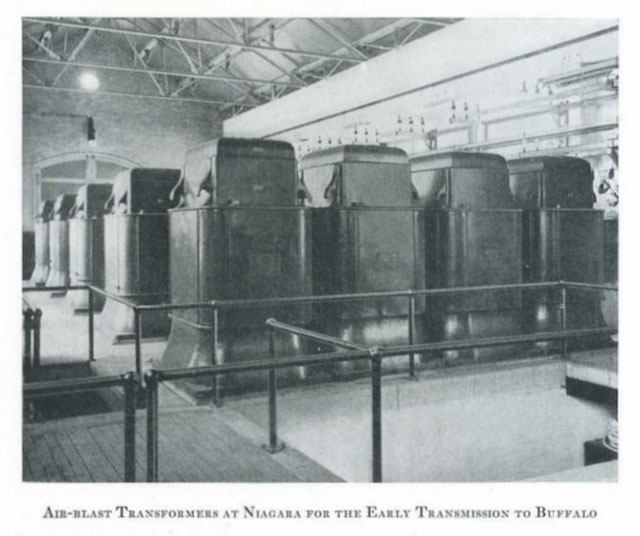
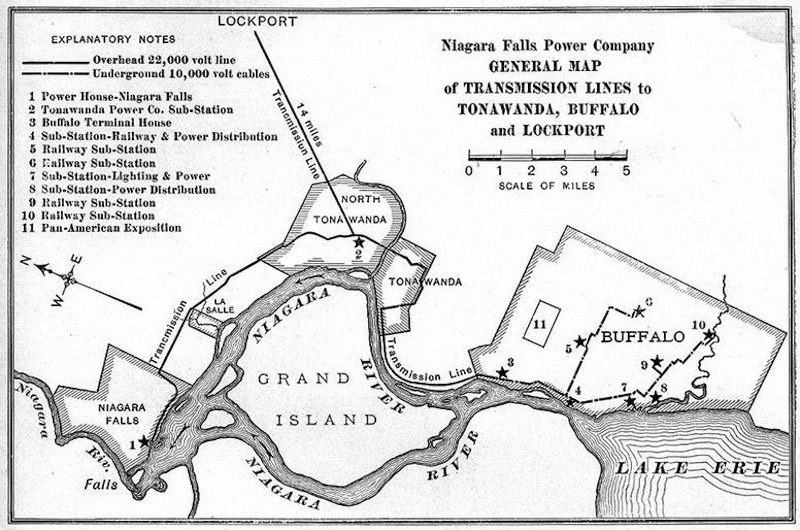
Opinions about Tesla's work
... a Westinghouse manager wrote to Nikola Tesla in 1893, “It must certainly be gratifying to you to think the largest water power in the world is to be utilized by a system which your ingenuity originated. Your successes are gradually pushing to the front. Let the good work go on.”
In 1894, the New York Times wrote the following: “To Tesla belongs the undisputed honor of being the man whose work made this Niagara enterprise possible…There could be no better evidence of the practical qualities of his inventive genius.”
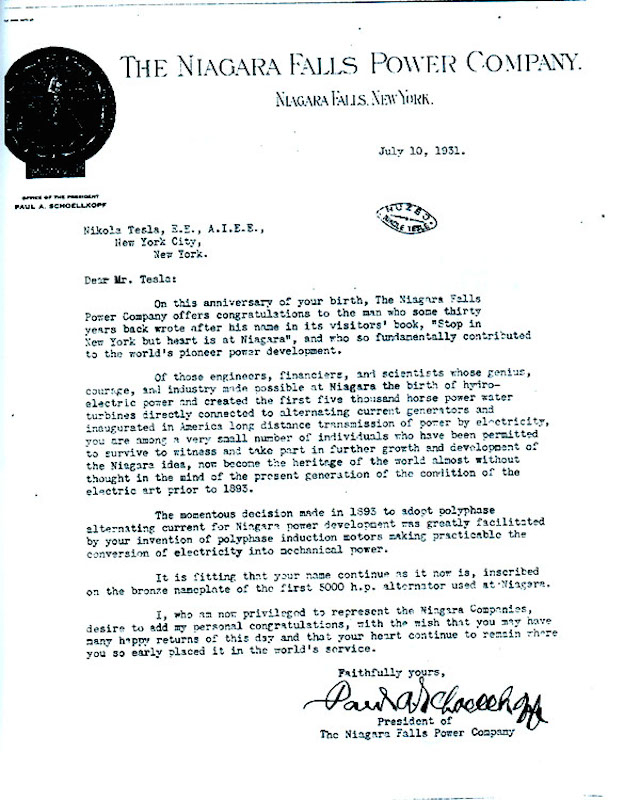
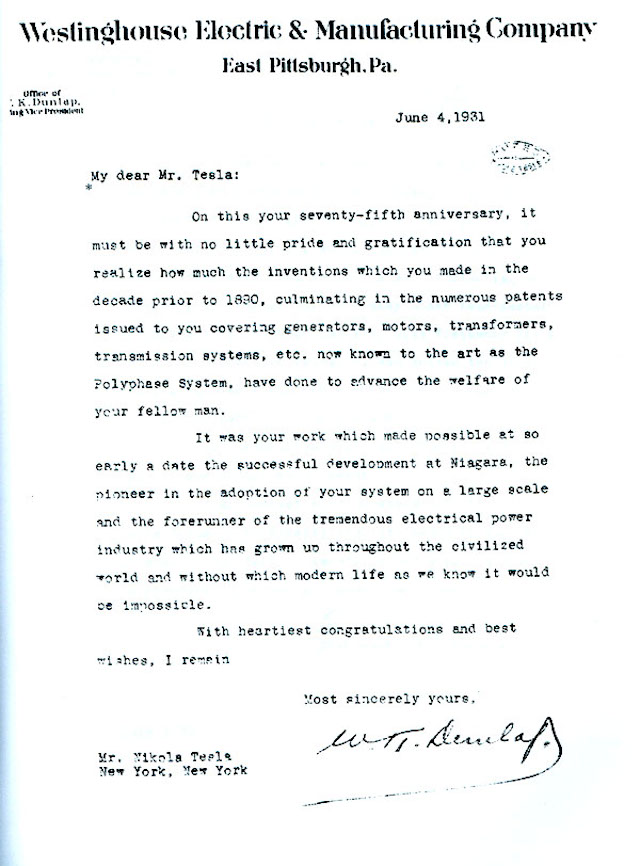
The Speech of Nikola Tesla in Buffalo in 1897
The speech of Nikola Tesla delivered in Buffalo during the solemn opening of the Niagara Hydroelectric Project, on 12th January 1897.
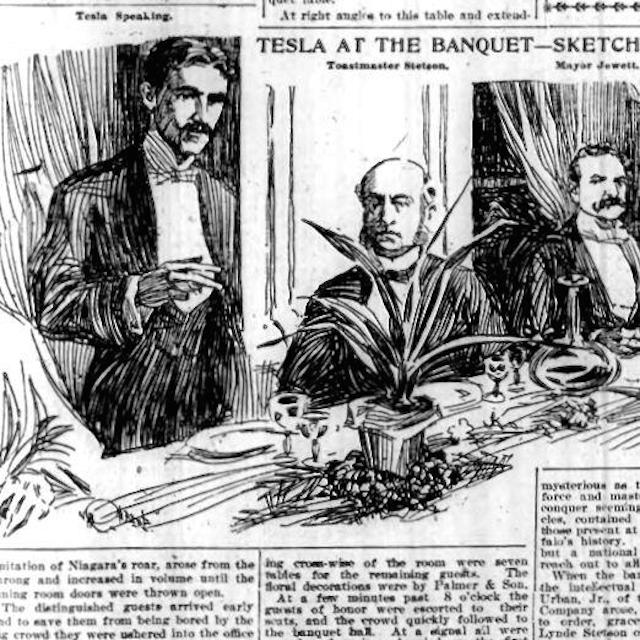
Besides Nikola Tesla, among 400 invited persons at the banquet in Buffalo, there were also
Grover Cleveland (president of the USA), Lord Kelvin, Alexander Graham Bell, George Westinghouse,
Thomas A. Edison, J. Pierpont Morgan, Jacob F. Schoellkopf.
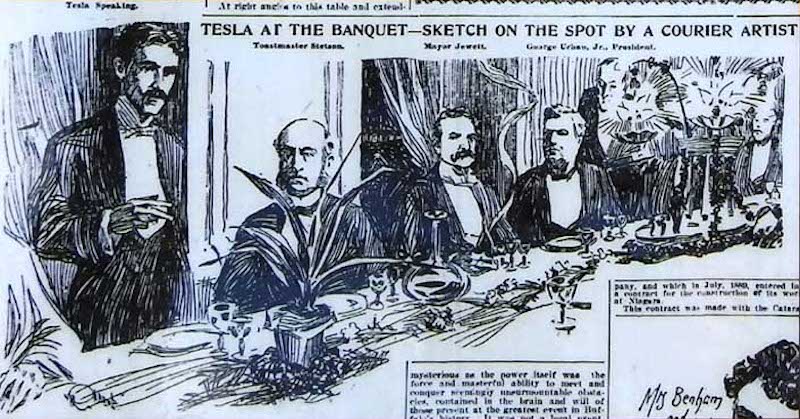
Tesla speaking at the banquet in Buffalo in 1897
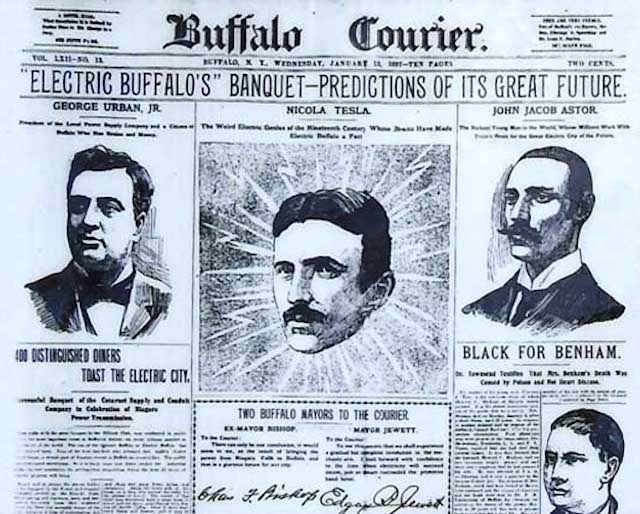
The title page of Buffalo Courier, January 12, 1897
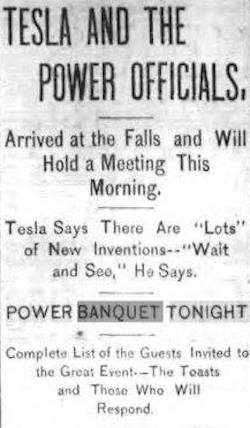
An initial part of an extensive article describing
the banquet in Buffalo 1897, which includes a list
of 400 invited persons. Prior to this, Tesla visited the Niagara Falls.
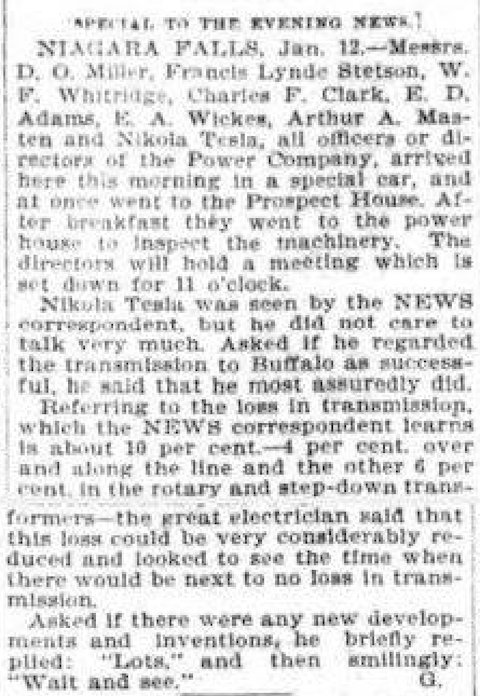
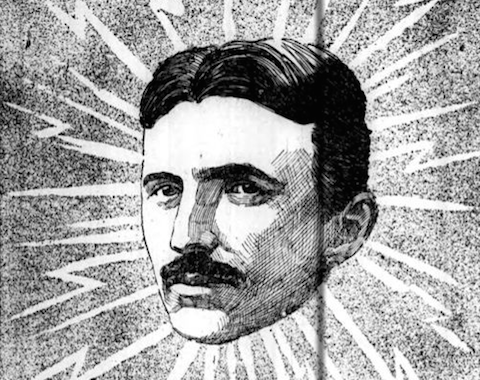 Nikola Tesla on the title page of Buffalo Courier, January 12, 1897. The crowd was made up of Buffalo’s upper class as well as wealthy investors from New York City and they were treated to a first-class dinner party. Guests wore top hats, cigars were smoked and a 10-course meal included oysters, deviled lobster and a dessert called “electric sorbet.” Dressed in a tuxedo, Tesla gave a toast: “... I wish to congratulate
you Buffalonians, I will say friends, on the wonderful expectations and
possibilities open to you. At some time not distant your city will be
on the border of the great cataract, which is one of the wonders of the
Nation.”
Melissa Brown, executive director of the Buffalo History Museum (2017): “I think we have a long way
to go to repay a debt to Nikola Tesla that still hasn’t been completely
satisfied,” she said. “He needs to be remembered. What he did was
really astounding. Every single one of our lives has been affected by
him – the whole system of electricity.”
She compared Tesla’s technological breakthrough to the advent of the internet. She recalled how people didn’t know what to make of the “world wide web” at first. “How will it effect us? Will it even take hold.” “I remember driving and seeing all the power lines and I thought: ‘My God. This infrastructure, this whole thing, is all the result of that development.’” Source buffalonews.com |
| Nikola Tesla: Electricity ...
But among all these many departments of research, these many branches of industry, new and old, which are being rapidly expanded, there is one dominating all others in importance—one which is of the greatest significance for the comfort and welfare, not to say for the existence, of mankind, and that is the electrical transmission of power. And in this most important of all fields, gentlemen, long afterwards, when time will have placed the events in their proper perspective, and assigned men to their deserved places, the great event we are commemorating today will stand out as designating a new and glorious epoch in the history of humanity—an epoch grander than that marked by the advent of the steam engine. We have many a monument of past ages: we have the palaces and pyramids, the temples of the Greek and the cathedrals of Christendom. In them is exemplified the power of men, the greatness of nations, the love of art and religious devotion. But that monument at Niagara has something of its own, more in accord with our present thoughts and tendencies. It is a monument worthy of our scientific age, a true monument of enlightenment and of peace. It signifies the subjugation of natural forces to the service of man, the discontinuance of barbarous methods, the relieving of millions from want and suffering. No matter what we attempt to do, no matter to what fields we turn our efforts, we are dependent on power. Our economists may propose more economical systems of administration and utilization of resources, our legislators may make wiser laws and treaties, it matters little; that kind of help can be only temporary. If we want to reduce poverty and misery, if we want to give to every deserving individual what is needed for a safe existence of an intelligent being, we want to provide more machinery, more power. Power is our mainstay, the primary source of our many-sided energies. With sufficient power at our disposal we can satisfy most of our wants and offer a guaranty for safe and comfortable existence to all, except perhaps to those who are the greatest criminals of all—the voluntarily idle. ...
But we shall not satisfy ourselves simply with improving steam and explosive engines or inventing new batteries; we have something much better to work for, a greater task to fulfill. We have to evolve means for obtaining energy from stores which are forever inexhaustible, to perfect methods which do not imply consumption and waste of any material whatever. Upon this great possibility, which I have long ago recognized, upon this great problem, the practical solution of which means so much for humanity, I have myself concentrated my efforts since a number of years, and a few happy ideas which came to me have inspired me to attempt the most difficult, and given me strength and courage in adversity. Nearly six years ago my confidence had become strong enough to prompt me to an expression of hope in the ultimate solution of this all dominating problem. I have made progress since, and have passed the stage of mere conviction such as is derived from a diligent study of known facts, conclusions and calculations. I now feel sure that the realization of that idea is not far off. But precisely for this reason I feel impelled to point out here an important fact, which I hope will be remembered. Having examined for a long time the possibilities of the development I refer to, namely, that of the operation of engines on any point of the earth by the energy of the medium, I find that even under the theoretically best conditions such a method of obtaining power can not equal in economy, simplicity and many other features the present method, involving a conversion fo the mechanical energy of running water into electrical energy and the transmission of the latter in the form of currents of very high tension to great distances. Provided, therefore, that we can avail ourselves of currents of sufficiently high tension, a waterfall affords us the most advantageous means of getting power from the sun sufficient for all our wants, and this recognition has impressed me strongly with the future importance of the water power, not so much because of its commercial value, though it may be very great, but chiefly because of its bearing upon our safety and welfare. I am glad to say that also in this latter direction my efforts have not been unsuccessful, for I have devised means which will allow us the use in power transmission of electromotive forces much higher than those practicable with ordinary apparatus. In fact, progress in this field has given me fresh hope that I shall see the fulfillment of one of my fondest dreams; namely, the transmission of power from station to station without the employment of any connecting wire. Still, whatever method of transmission be ultimately adopted, nearness to the source of power will remain an important advantage. Gentlemen, some of the ideas I have expressed may appear to many of you hardly realizable; nevertheless, they are the result of long-continued thought and work. You would judge them more justly if you would have devoted your life to them, as I have done. With ideas it is like with dizzy heights you climb: At first they cause you discomfort and you are anxious to get down, distrustful of your own powers; but soon the remoteness of the turmoil of life and the inspiring influence of the altitude calm your blood; your step gets firm and sure and you begin to look—for dizzier heights. I have attempted to speak to you on “Electricity,” its development and influence, but I fear that I have done it much like a boy who tries to draw a likeness with a few straight lines. But I have endeavored to bring out one feature, to speak to you in one strain which I felt sure would find response in the hearts of all of you, the only one worthy of this occasion—the humanitarian. In the great enterprise at Niagara we see not only a bold engineering and commercial feat, but far more, a giant stride in the right direction as indicated both by exact science and philanthropy. Its success is a signal for the utilization of water powers all over the world, and its influence upon industrial development is incalculable. We must all rejoice in the great achievement and congratulate the intrepid pioneers who have joined their efforts and means to bring it about. It is a pleasure to learn of the friendly attitude of the citizens of Buffalo and of the encouragement given to the enterprise by the Canadian authorities. We shall hope that other cities, like Rochester on this side and Hamilton and Toronto in Canada, will soon follow Buffalo’s lead. This fortunate city herself is to be congratulated. With resources now unequaled, with commercial facilities and advantages such as few cities in the world possess, and with the enthusiasm and progressive spirit of its citizens, it is sure to become one of the greatest industrial centers of the globe. (Emphasized by D.Ž.) The speech of Nikola Tesla delivered in Buffalo in 1897 |
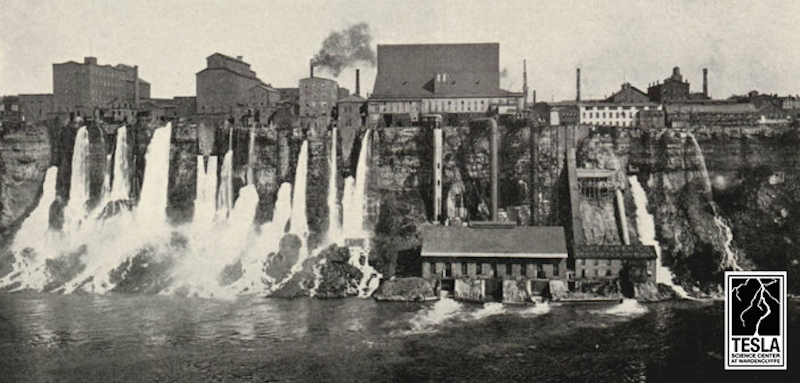
Here we reproduce a photo from TeslaScienceCenter.org indicated there as "The hydroelectric plant at Niagara, c. 1895".
However, according to our understanding, in the middle below of the photo are The Schoellkopf Power Plant No 2 and smaller No 1
(described above on this web page).
In the middle above of the photo is the Pittsburgh Reduction Co. - i.e., the Aluminum Factory No II.
Nikola Tesla's speech delivered in Buffalo is from 1897, while the photo is from 1898 or later.
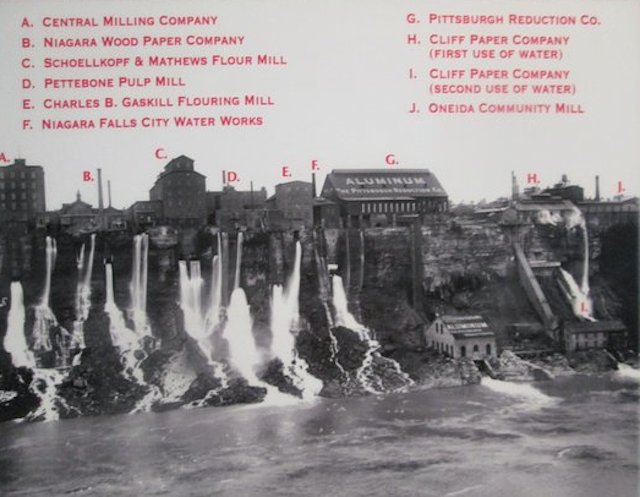
Earlier view (with respect to the photo above) to the Schoellkopf Power Plant No 2, with Aluminum Factory No II.
Additional references and the corresponding comments
https://www.niagarafallsinfo.com/niagara-falls-history/niagara-falls-power-development/the-history-of-power-development-in-niagara/powerhouse-1-2/
https://irma.nps.gov/DataStore/DownloadFile/582126
In the late summer of 1895, the company established an installation a short distance upriver from the Niagara Falls Power Company, from which it leased land and obtained electricity.
...
The steady stream of electricity that the Niagara Falls Power Company had to sell soon attracted new and larger industries to Niagara Falls. Fully aware of the potential, the power company acquired a large amount of land upriver and inland from the plant. The company planned to lease this land to its future customers and even engaged the services of Olmsted Brothers, the leading landscape architecture firm in the United States, to map and perhaps make suggestions for arranging the site, which was served by the Niagara Junction Railway Company. Thus, the company envisioned becoming landlord as well as energy supplier to the area’s new electroprocess industries. Their investment soon proved profitable. “Actual plant investment, exclusive of the power companies,” reported a writer in 1900, has grown from $500,000 to $1,500,000 in the three years that electrical power has been sold . . . and plans for extensions, improvements, and fresh investment are freely discussed.
...
Hydroelectric power was cheapest, however, when consumed close to its source of production. “Here companies can offer power here at very attractive prices,” observed a contemporary newspaper reporter. However, when transmission is involved, he noted, prices must advance because of waste, which amounts to 20 per cent between here [Niagara Falls] and Buffalo. The charge here is $20 per horsepower. At Buffalo it is $25. If the proportion of waste were continued to Rochester, seventy-five miles away, it would be 60 per cent, and the price at Rochester would be nearly $35 per horse power.
...
Among the tenants of the NFPC at the beginning of the twentieth century were the Carborundum Company, Union Carbide, Niagara Electro-Chemical Company, Niagara Falls Water Works, International Paper Company, the Electrical Lead Reduction Company, Acheson Graphite Company, Francis Hook and Fastener Company, and the Natural Food Company.
...
Historically, the industries of Niagara Falls were located in one of three areas: the High Bank (Milling District) along the gorge rim somewhat down river from the Falls; the Buffalo Avenue industrial area in the eastern section of the city; and the Highland Avenue area in the north part of town.
...
At the dawn of the new century, the Pan-American Exposition in Buffalo (1901.) introduced the world at large to the great leap forward that had begun in the few years earlier at Niagara Falls. This new industrial revolution brought great prosperity to the city of Niagara Falls, which grew from a population of 5500 in 1899 to over 90,000 by the middle of the twentieth century.
http://teslapodcast.com/2021/01/11/show-notes-028-war-of-the-currents-part-8-victory-niagara-1893-1897/
...
Luckily, the Niagara Falls Power Company had the Pittsburgh Reduction Plant as a client, because it wouldn’t be until December 16, 1895—after more than 14 months of negotiation—that Rankine and the City of Buffalo finally struck a deal that would send Niagara Falls electricity to Buffalo.
...
For four years, Tesla had turned down repeated invitations to visit the site as it was under construction. It was not until the summer of 1896 that Tesla finally decided to make the pilgrimage.
The trip began in Pittsburgh with George Westinghouse and a tour of his company’s new twenty-acre electrical works out in Turtle Valley, east of Pittsburgh. That evening, Edward Dean Adams and several others joined for an overnight journey to the Falls aboard the Glen Eyre, Westinghouse’s “sumptuous private railcar.”
The next morning, at 9:00 A.M. on Sunday, July 19, 1896—the height of tourist season—Tesla and his party (made up of Westinghouse and his son, thirteen-year-old George Jr., Westinghouse’s attorney Paul Cravath, Edward Dean Adams, and William Rankine) arrived at Niagara Falls, NY.
When they were ready to set out for the power station, the group took an electric trolley along Erie Avenue toward the edge of town, and toward Stanford White’s “many-windowed cathedral of power.” Power House No. 1, fronted by a broad lawn, sat on one side of the inlet canal where diverted river water flowed steadily into the powerhouse.
...
That is how, for the second time in six months, Tesla found himself heading up to Niagara—this time to be the guest of honour at a banquet to celebrate the completion of the Niagara Falls project.
Tesla traveled overnight in a private railcar from New York City with Edward Dean Adams and not a few of New York’s finest 1-percenters and millionaire directors of the Niagara endeavour.
Amongst them were Francis Lynde Stetson, one of the most powerful attorneys in America. From a distinguished New York legal and political family, Stetson was a confidant of President Grover Cleveland (who was also a partner in his law firm). He had represented the railroad interests of the Vanderbilts since 1887, and J. P. Morgan had Stetson’s firm on retainer.
Edward Wickes was also in the party. Likewise a lawyer, and likewise on retainer to the Vanderbilts and their interests in the New York Central railroad, Wickes and Stetson were both vice presidents of the Cataract Construction Company.
One of the non-millionaires who journeyed with them was Lewis B. Stillwell, Westinghouse’s chief engineer who was standing in for the great man, and whom we first met back in Episode 12 when Tesla went to Pittsburgh to work with the Westinghouse people to develop his motor and dynamo for commercial use.
https://www.buffaloah.com/a/nf/adams/index.html
https://ethw.org/Early_Electrification_of_Buffalo
...
1952 60-Hz peak load exceeded the 25-Hz peak load
https://teslaresearch.jimdofree.com/niagara-falls-power-project-1888/
The Niagara Falls Power Company (NFPC) and its subsidiary Cataract Company formed the International Niagara Commission composed of experts, to analyze proposals to harness Niagara Falls to generate electricity. The commission was led by Sir William Thomson (later Lord Kelvin) and included Eleuthère Mascart from France, William Unwin from England, Coleman Sellers from the US, and Théodore Turrettini from Switzerland. It was backed by entrepreneurs such as J. P. Morgan, Lord Rothschild, and John Jacob Astor IV. Among 19 proposals, they even briefly considered compressed air as a power transmission medium, but preferred electricity.
The fundamental Tesla patents granted on May 1888 expired on May 4, 1905 and became public property.
"Tesla split-phase patents" US511,559 - Electrical Transmission of Power - December 26, 1893 & US511,560 - System of Electrical Power Transmission - December 26, 1893 (both issued on September 26, 1893) expired on December 26, 1910.
https://www.omnicalculator.com/physics/three-phase
Niagara Falls Tesla's power generators were 5000 hp of power, 2200 V voltage. Calculator gives 1090 A of three-phase current. But be careful, in fact it was 1630 A of two-phase current, 25 Hz.
Transformers were Scott connected from two-phase 4-wire 2200 V to 3-phase 3-wire 11000 V.
Transmission line to Buffalo was three-phase, 11 kV, 1250 hp, 55 A, later increased to 22 kV, 2500 hp, 55 A.
Note that four 1250 hp transformers would fit to one 5000 hp power generator.
Also, all currents mentioned on this web page are estimates based on limited web inputs for calculations.
https://www.youtube.com/watch?v=-ECA9NsN9vw
https://youtu.be/HpWu1Su2wE8
https://youtu.be/Ok8JDXSYw1U
Literature
Nikola Tesla and Croatians
- Nikola Tesla and his schooling in Croatia
- Nikola Tesla and Croatians
- Nikola Tesla u gradu Zagrebu 1892.
- Nikola Tesla's assistant Charles Scott
Sources related to the content of this web page
- Adams Power Plant Transformer House
- Adams Power Station
- The speech of Nikola Tesla delivered in Buffalo during the solemn opening of the Niagara Hydroelectric Project, on 12th January 1897.
Nikola Tesla and his schooling in Croatia
Nikola Tesla in the city of Zagreb in 1892
Croatia, its History, Culture and Science
